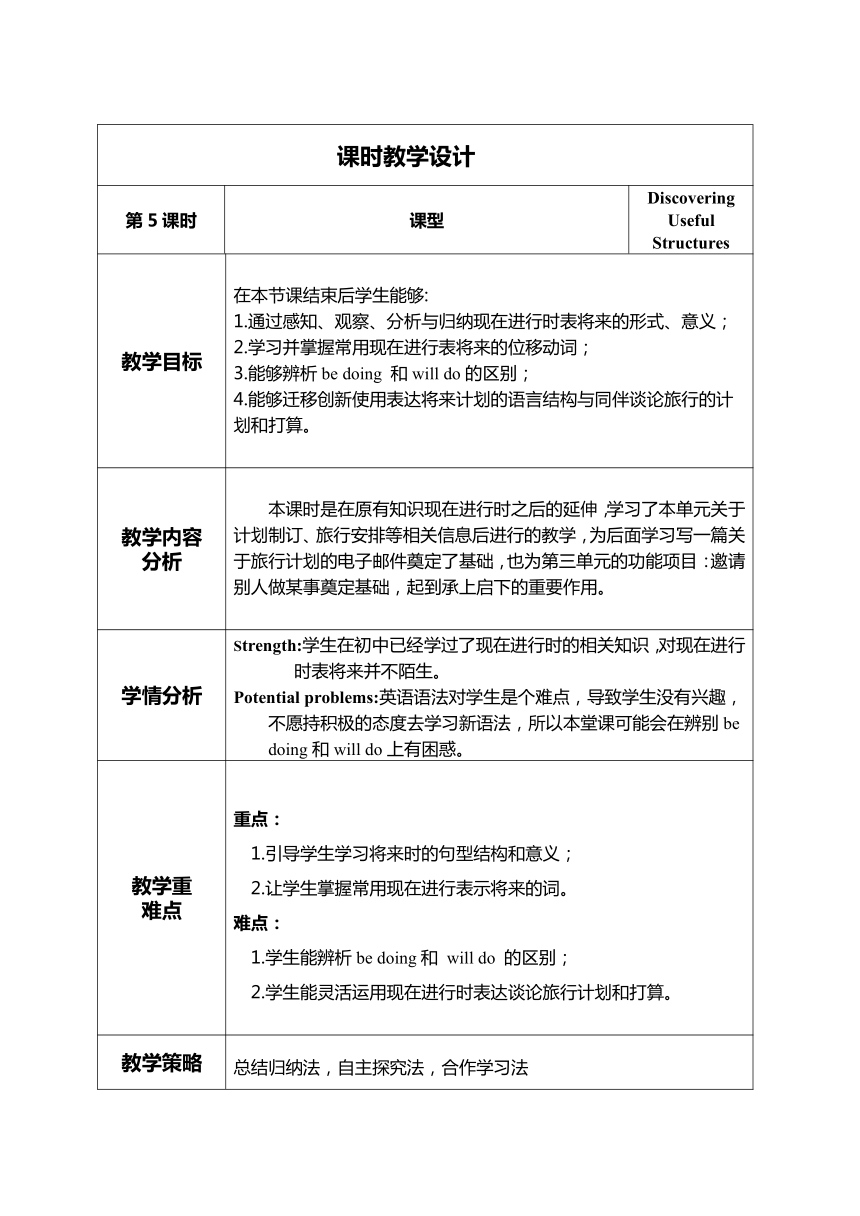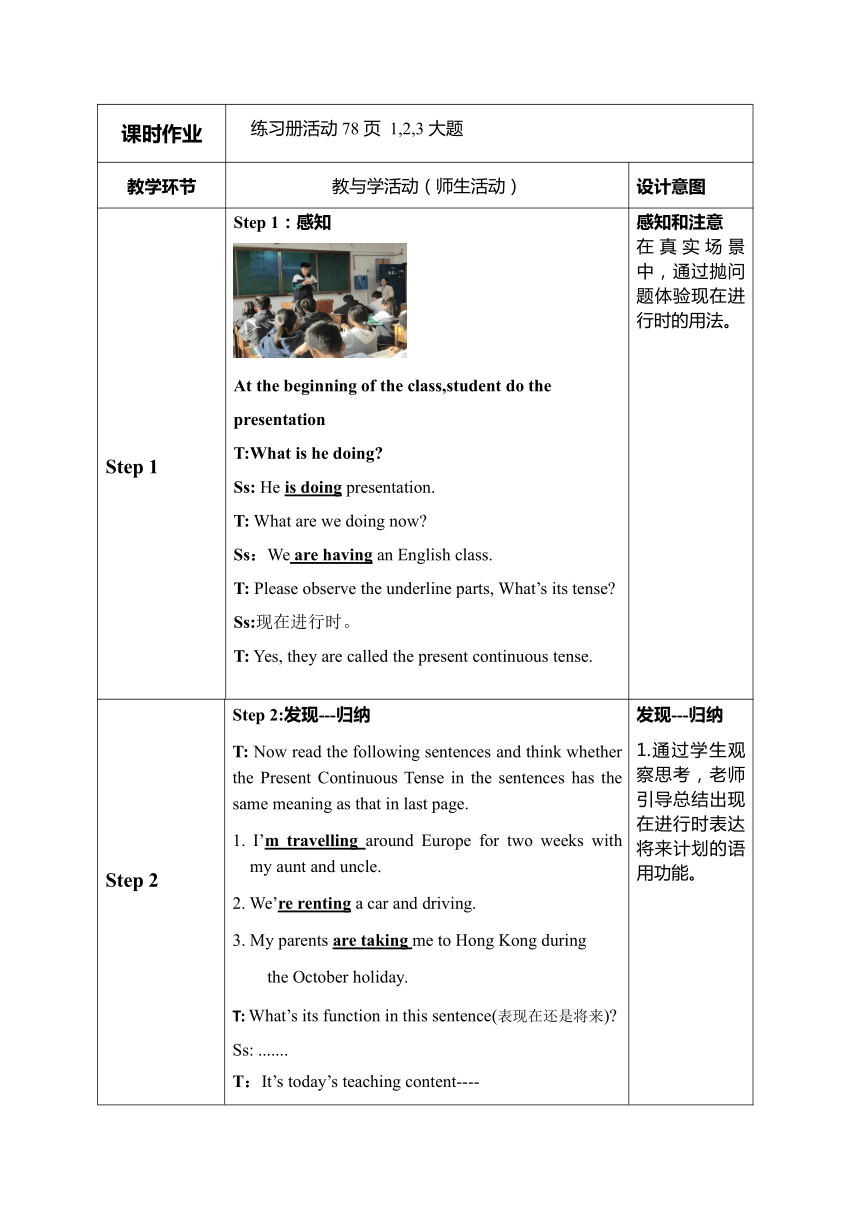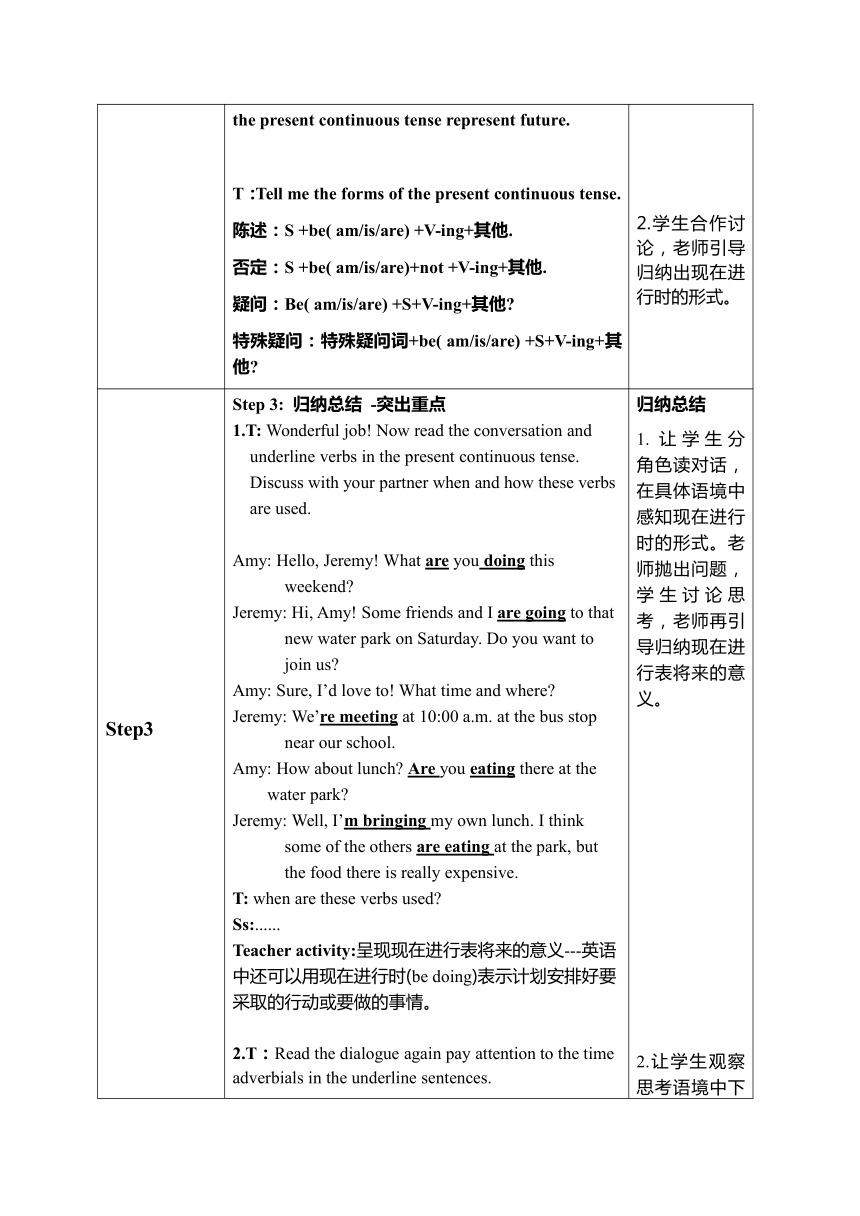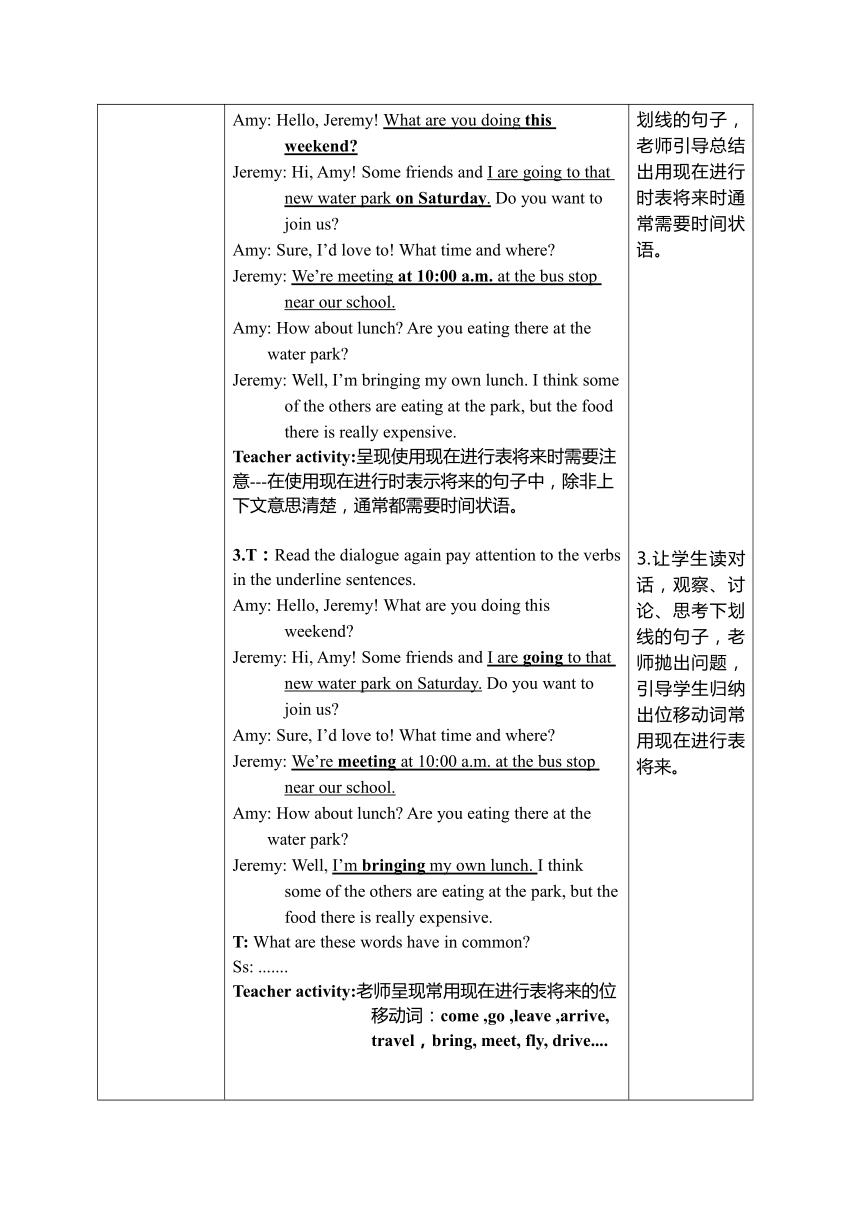Unit 4 Natural Disaster Discovering Useful Structures 教学设计
文档属性
| 名称 | Unit 4 Natural Disaster Discovering Useful Structures 教学设计 |

|
|
| 格式 | doc | ||
| 文件大小 | 608.5KB | ||
| 资源类型 | 试卷 | ||
| 版本资源 | 人教版(2019) | ||
| 科目 | 英语 | ||
| 更新时间 | 2021-11-26 18:36:02 | ||
图片预览




文档简介
课时教学设计
第5课时 课型 Discovering Useful Structures
教学目标 在本节课结束后学生能够:1.通过感知、观察、分析与归纳现在进行时表将来的形式、意义;2.学习并掌握常用现在进行表将来的位移动词;3.能够辨析be doing 和will do的区别;4.能够迁移创新使用表达将来计划的语言结构与同伴谈论旅行的计划和打算。
教学内容分析 本课时是在原有知识现在进行时之后的延伸,学习了本单元关于计划制订、旅行安排等相关信息后进行的教学,为后面学习写一篇关于旅行计划的电子邮件奠定了基础,也为第三单元的功能项目:邀请别人做某事奠定基础,起到承上启下的重要作用。
学情分析 Strength:学生在初中已经学过了现在进行时的相关知识,对现在进行时表将来并不陌生。Potential problems:英语语法对学生是个难点,导致学生没有兴趣,不愿持积极的态度去学习新语法,所以本堂课可能会在辨别be doing和will do上有困惑。
教学重难点 重点:1.引导学生学习将来时的句型结构和意义;2.让学生掌握常用现在进行表示将来的词。难点:1.学生能辨析be doing和 will do 的区别;2.学生能灵活运用现在进行时表达谈论旅行计划和打算。
教学策略 总结归纳法,自主探究法,合作学习法
课时作业 练习册活动78页 1,2,3大题
教学环节 教与学活动(师生活动) 设计意图
Step 1 Step 1:感知At the beginning of the class,student do the presentationT:What is he doing Ss: He is doing presentation.T: What are we doing now Ss:We are having an English class.T: Please observe the underline parts, What’s its tense Ss:现在进行时。T: Yes, they are called the present continuous tense. 感知和注意在真实场景中,通过抛问题体验现在进行时的用法。
Step 2 Step 2:发现---归纳T: Now read the following sentences and think whether the Present Continuous Tense in the sentences has the same meaning as that in last page.1. I’m travelling around Europe for two weeks with my aunt and uncle.2. We’re renting a car and driving.3. My parents are taking me to Hong Kong during the October holiday.T: What’s its function in this sentence(表现在还是将来) Ss: .......T:It’s today’s teaching content----the present continuous tense represent future.T:Tell me the forms of the present continuous tense.陈述:S +be( am/is/are) +V-ing+其他.否定:S +be( am/is/are)+not +V-ing+其他.疑问:Be( am/is/are) +S+V-ing+其他 特殊疑问:特殊疑问词+be( am/is/are) +S+V-ing+其他 发现---归纳1.通过学生观察思考,老师引导总结出现在进行时表达将来计划的语用功能。2.学生合作讨论,老师引导归纳出现在进行时的形式。
Step3 Step 3: 归纳总结 -突出重点1.T: Wonderful job! Now read the conversation and underline verbs in the present continuous tense. Discuss with your partner when and how these verbs are used.Amy: Hello, Jeremy! What are you doing this weekend Jeremy: Hi, Amy! Some friends and I are going to that new water park on Saturday. Do you want to join us Amy: Sure, I’d love to! What time and where Jeremy: We’re meeting at 10:00 a.m. at the bus stop near our school.Amy: How about lunch Are you eating there at the water park Jeremy: Well, I’m bringing my own lunch. I think some of the others are eating at the park, but the food there is really expensive. T: when are these verbs used Ss:......Teacher activity:呈现现在进行表将来的意义---英语中还可以用现在进行时(be doing)表示计划安排好要采取的行动或要做的事情。2.T:Read the dialogue again pay attention to the time adverbials in the underline sentences.Amy: Hello, Jeremy! What are you doing this weekend Jeremy: Hi, Amy! Some friends and I are going to that new water park on Saturday. Do you want to join us Amy: Sure, I’d love to! What time and where Jeremy: We’re meeting at 10:00 a.m. at the bus stop near our school.Amy: How about lunch Are you eating there at the water park Jeremy: Well, I’m bringing my own lunch. I think some of the others are eating at the park, but the food there is really expensive.Teacher activity:呈现使用现在进行表将来时需要注意---在使用现在进行时表示将来的句子中,除非上下文意思清楚,通常都需要时间状语。3.T:Read the dialogue again pay attention to the verbs in the underline sentences.Amy: Hello, Jeremy! What are you doing this weekend Jeremy: Hi, Amy! Some friends and I are going to that new water park on Saturday. Do you want to join us Amy: Sure, I’d love to! What time and where Jeremy: We’re meeting at 10:00 a.m. at the bus stop near our school.Amy: How about lunch Are you eating there at the water park Jeremy: Well, I’m bringing my own lunch. I think some of the others are eating at the park, but the food there is really expensive.T: What are these words have in common Ss: .......Teacher activity:老师呈现常用现在进行表将来的位移动词:come ,go ,leave ,arrive, travel,bring, meet, fly, drive.... 归纳总结让学生分角色读对话,在具体语境中感知现在进行时的形式。老师抛出问题,学生讨论思考,老师再引导归纳现在进行表将来的意义。2.让学生观察思考语境中下划线的句子,老师引导总结出用现在进行时表将来时通常需要时间状语。3.让学生读对话,观察、讨论、思考下划线的句子,老师抛出问题,引导学生归纳出位移动词常用现在进行表将来。
Step 4 Step 4:运用-突破难点T: You did a good job! Now read the sentences and tick those that express future plans p28. Then, Rewrite them in the present continuous tense. _____ I’ve just booked my air ticket! I’ll visit my grandparents in December. 2._____Gary might visit China next year,but he’s still not sure. 3._____Kate has been invited to a meeting in Iceland. She will apply for a visa soon. 4._____Could you help me with this box,please I’m afraid I’m going to drop it. 5. A:Hey,are you free for dinner tonight _____B:I’m sorry,no. I’ll have dinner with my cousins tonight.改写后的句子:1.I’ve just booked my air ticket! I am visiting my grandparents in December. 3.Kate has been invited to a meeting in Iceland. She is applying for a visa soon. 5.I’m sorry,no. I am having dinner with my cousins tonight.Teacher’s activity: 组织学生互对答案,并讨论思考二、四句不能改写的原因。T: Let’s do summary.be doing表示将来与be going to do和will dobe doing强调事先计划好的安排、确定要做的事情;will do更强调个人意愿和瞬间的决定。be going to表示说话者的打算和意图,还可以表示根据当前情况作出的预言。T: Well down.Tick the sentences expressing future plans and change will do into the present continuous tense.Then complete the email. The Cruise will leave on 23 March and return on 1 April. We will take a cruise to Tailand. I know you will want to read more about the tour. I will also send you the brochure soon.Dear Dad, I hope you and Mum are well! Mia and I want to invite you to join us for our spring holiday. (We are taking a cruise to Tailand.)We found a great package tour for the end of March.( The Cruise is leaving on 23 March and return on 1 April.)Mia is especially excited about the trip. She loves warm weather! I really hope you can come with us.(I know you will want to read more about the tour.)You can find more information online.(I will also send you the brochure soon.) Let me know what you think!Love,Paul 运用突破难点1.学生读句子讨论思考能改写和不能改写的原因,老师引导学生辨析一般将来时与现在进行时表达将来的区别,并复习be going to 的用法,为后面运用铺垫基础。2.让学生在具体语境中再次巩固现在进行时表示将来结构的运用。
Step 5 Step 5 迁移运用T:Good job! Let’s discuss weekend plans with a partner,based on the weather report below. EXAMPLE: A:What are you doing on Saturday morning B: Well,it’s going to be sunny in the morning and not very windy,so I’m having a picnic with my friends. .... ... T: These verbs are used to talk about arrangements for events in the future. 迁移运用学生在理解并掌握现在进行表将来的基础上,根据所给场景,让学生合作讨论周末计划,学会迁移运用所学语法知识。
Step 6 链接高考1.Ladies and gentlemen, please fasten your seat belts.The plane_____(take) off. (全国卷)2.I hear that you will go to Beijing this afternoon.Who____(see) you off at the airport (浙江卷)3.I have studied at the university for three years already and I______ (graduate) from here in one month.(全国卷II)4.Since I won the big prize, my telephone hasn't stopped ringing.People____(phone) to ask how I _____(go)to spend the money.(湖南卷)5.My parents_____ (take) me to Hongkong to visit my grandmother this winter holiday.(全国卷I) 链接高考设置语法填空,链接高考,让学生体验这语法项目在高考题型中的运用。
Step 7 Step7 梳理整合be doing强调事先计划好的安排、确定要做的事情;will do更强调个人意愿和瞬间的决定。 be going to表示说话者的打算和意图,还可以表示根据当前情况作出的预言。常用动词为位移动词:come ,go ,leave ,arrive, travel.... 梳理整合给学生梳理本节课的要点,培养学生归纳总结的能力。
Step 8 Homework:迁移创新,运用所学知识表达个人观点Write down your plan for the winter holiday.Please use present continuous tense to express future actions. 迁移创新,运用所学知识表达个人观点让学生运用现在进行时表将来的结构描述自己的寒假计划,学会迁移创新。
板书设计 Unit 2 Travelling AroundSection E Discovering Useful Structures一、常用于现在进行时表将来的词:go,meet,bring,come ,go ,leave ,arrive, travel... 二、表将来的结构:1.am/is/are +V - ing2.will +V 3.be going to
教学反思 在语言使用中,语法知识是“形式-意义-使用”的统一体,本堂课活动设计遵循“发现-归纳-练习-运用”的思路,及时归纳总结,有助于学生将新旧知识联系起来,形成整体化、系统化的知识体系。1.通过创设语境,让学生在具体语境下关注它的形式、意义和使用。2.通过小组合作和梳理总结的环节,培养学生合作精神和归纳总结的能力。
第5课时 课型 Discovering Useful Structures
教学目标 在本节课结束后学生能够:1.通过感知、观察、分析与归纳现在进行时表将来的形式、意义;2.学习并掌握常用现在进行表将来的位移动词;3.能够辨析be doing 和will do的区别;4.能够迁移创新使用表达将来计划的语言结构与同伴谈论旅行的计划和打算。
教学内容分析 本课时是在原有知识现在进行时之后的延伸,学习了本单元关于计划制订、旅行安排等相关信息后进行的教学,为后面学习写一篇关于旅行计划的电子邮件奠定了基础,也为第三单元的功能项目:邀请别人做某事奠定基础,起到承上启下的重要作用。
学情分析 Strength:学生在初中已经学过了现在进行时的相关知识,对现在进行时表将来并不陌生。Potential problems:英语语法对学生是个难点,导致学生没有兴趣,不愿持积极的态度去学习新语法,所以本堂课可能会在辨别be doing和will do上有困惑。
教学重难点 重点:1.引导学生学习将来时的句型结构和意义;2.让学生掌握常用现在进行表示将来的词。难点:1.学生能辨析be doing和 will do 的区别;2.学生能灵活运用现在进行时表达谈论旅行计划和打算。
教学策略 总结归纳法,自主探究法,合作学习法
课时作业 练习册活动78页 1,2,3大题
教学环节 教与学活动(师生活动) 设计意图
Step 1 Step 1:感知At the beginning of the class,student do the presentationT:What is he doing Ss: He is doing presentation.T: What are we doing now Ss:We are having an English class.T: Please observe the underline parts, What’s its tense Ss:现在进行时。T: Yes, they are called the present continuous tense. 感知和注意在真实场景中,通过抛问题体验现在进行时的用法。
Step 2 Step 2:发现---归纳T: Now read the following sentences and think whether the Present Continuous Tense in the sentences has the same meaning as that in last page.1. I’m travelling around Europe for two weeks with my aunt and uncle.2. We’re renting a car and driving.3. My parents are taking me to Hong Kong during the October holiday.T: What’s its function in this sentence(表现在还是将来) Ss: .......T:It’s today’s teaching content----the present continuous tense represent future.T:Tell me the forms of the present continuous tense.陈述:S +be( am/is/are) +V-ing+其他.否定:S +be( am/is/are)+not +V-ing+其他.疑问:Be( am/is/are) +S+V-ing+其他 特殊疑问:特殊疑问词+be( am/is/are) +S+V-ing+其他 发现---归纳1.通过学生观察思考,老师引导总结出现在进行时表达将来计划的语用功能。2.学生合作讨论,老师引导归纳出现在进行时的形式。
Step3 Step 3: 归纳总结 -突出重点1.T: Wonderful job! Now read the conversation and underline verbs in the present continuous tense. Discuss with your partner when and how these verbs are used.Amy: Hello, Jeremy! What are you doing this weekend Jeremy: Hi, Amy! Some friends and I are going to that new water park on Saturday. Do you want to join us Amy: Sure, I’d love to! What time and where Jeremy: We’re meeting at 10:00 a.m. at the bus stop near our school.Amy: How about lunch Are you eating there at the water park Jeremy: Well, I’m bringing my own lunch. I think some of the others are eating at the park, but the food there is really expensive. T: when are these verbs used Ss:......Teacher activity:呈现现在进行表将来的意义---英语中还可以用现在进行时(be doing)表示计划安排好要采取的行动或要做的事情。2.T:Read the dialogue again pay attention to the time adverbials in the underline sentences.Amy: Hello, Jeremy! What are you doing this weekend Jeremy: Hi, Amy! Some friends and I are going to that new water park on Saturday. Do you want to join us Amy: Sure, I’d love to! What time and where Jeremy: We’re meeting at 10:00 a.m. at the bus stop near our school.Amy: How about lunch Are you eating there at the water park Jeremy: Well, I’m bringing my own lunch. I think some of the others are eating at the park, but the food there is really expensive.Teacher activity:呈现使用现在进行表将来时需要注意---在使用现在进行时表示将来的句子中,除非上下文意思清楚,通常都需要时间状语。3.T:Read the dialogue again pay attention to the verbs in the underline sentences.Amy: Hello, Jeremy! What are you doing this weekend Jeremy: Hi, Amy! Some friends and I are going to that new water park on Saturday. Do you want to join us Amy: Sure, I’d love to! What time and where Jeremy: We’re meeting at 10:00 a.m. at the bus stop near our school.Amy: How about lunch Are you eating there at the water park Jeremy: Well, I’m bringing my own lunch. I think some of the others are eating at the park, but the food there is really expensive.T: What are these words have in common Ss: .......Teacher activity:老师呈现常用现在进行表将来的位移动词:come ,go ,leave ,arrive, travel,bring, meet, fly, drive.... 归纳总结让学生分角色读对话,在具体语境中感知现在进行时的形式。老师抛出问题,学生讨论思考,老师再引导归纳现在进行表将来的意义。2.让学生观察思考语境中下划线的句子,老师引导总结出用现在进行时表将来时通常需要时间状语。3.让学生读对话,观察、讨论、思考下划线的句子,老师抛出问题,引导学生归纳出位移动词常用现在进行表将来。
Step 4 Step 4:运用-突破难点T: You did a good job! Now read the sentences and tick those that express future plans p28. Then, Rewrite them in the present continuous tense. _____ I’ve just booked my air ticket! I’ll visit my grandparents in December. 2._____Gary might visit China next year,but he’s still not sure. 3._____Kate has been invited to a meeting in Iceland. She will apply for a visa soon. 4._____Could you help me with this box,please I’m afraid I’m going to drop it. 5. A:Hey,are you free for dinner tonight _____B:I’m sorry,no. I’ll have dinner with my cousins tonight.改写后的句子:1.I’ve just booked my air ticket! I am visiting my grandparents in December. 3.Kate has been invited to a meeting in Iceland. She is applying for a visa soon. 5.I’m sorry,no. I am having dinner with my cousins tonight.Teacher’s activity: 组织学生互对答案,并讨论思考二、四句不能改写的原因。T: Let’s do summary.be doing表示将来与be going to do和will dobe doing强调事先计划好的安排、确定要做的事情;will do更强调个人意愿和瞬间的决定。be going to表示说话者的打算和意图,还可以表示根据当前情况作出的预言。T: Well down.Tick the sentences expressing future plans and change will do into the present continuous tense.Then complete the email. The Cruise will leave on 23 March and return on 1 April. We will take a cruise to Tailand. I know you will want to read more about the tour. I will also send you the brochure soon.Dear Dad, I hope you and Mum are well! Mia and I want to invite you to join us for our spring holiday. (We are taking a cruise to Tailand.)We found a great package tour for the end of March.( The Cruise is leaving on 23 March and return on 1 April.)Mia is especially excited about the trip. She loves warm weather! I really hope you can come with us.(I know you will want to read more about the tour.)You can find more information online.(I will also send you the brochure soon.) Let me know what you think!Love,Paul 运用突破难点1.学生读句子讨论思考能改写和不能改写的原因,老师引导学生辨析一般将来时与现在进行时表达将来的区别,并复习be going to 的用法,为后面运用铺垫基础。2.让学生在具体语境中再次巩固现在进行时表示将来结构的运用。
Step 5 Step 5 迁移运用T:Good job! Let’s discuss weekend plans with a partner,based on the weather report below. EXAMPLE: A:What are you doing on Saturday morning B: Well,it’s going to be sunny in the morning and not very windy,so I’m having a picnic with my friends. .... ... T: These verbs are used to talk about arrangements for events in the future. 迁移运用学生在理解并掌握现在进行表将来的基础上,根据所给场景,让学生合作讨论周末计划,学会迁移运用所学语法知识。
Step 6 链接高考1.Ladies and gentlemen, please fasten your seat belts.The plane_____(take) off. (全国卷)2.I hear that you will go to Beijing this afternoon.Who____(see) you off at the airport (浙江卷)3.I have studied at the university for three years already and I______ (graduate) from here in one month.(全国卷II)4.Since I won the big prize, my telephone hasn't stopped ringing.People____(phone) to ask how I _____(go)to spend the money.(湖南卷)5.My parents_____ (take) me to Hongkong to visit my grandmother this winter holiday.(全国卷I) 链接高考设置语法填空,链接高考,让学生体验这语法项目在高考题型中的运用。
Step 7 Step7 梳理整合be doing强调事先计划好的安排、确定要做的事情;will do更强调个人意愿和瞬间的决定。 be going to表示说话者的打算和意图,还可以表示根据当前情况作出的预言。常用动词为位移动词:come ,go ,leave ,arrive, travel.... 梳理整合给学生梳理本节课的要点,培养学生归纳总结的能力。
Step 8 Homework:迁移创新,运用所学知识表达个人观点Write down your plan for the winter holiday.Please use present continuous tense to express future actions. 迁移创新,运用所学知识表达个人观点让学生运用现在进行时表将来的结构描述自己的寒假计划,学会迁移创新。
板书设计 Unit 2 Travelling AroundSection E Discovering Useful Structures一、常用于现在进行时表将来的词:go,meet,bring,come ,go ,leave ,arrive, travel... 二、表将来的结构:1.am/is/are +V - ing2.will +V 3.be going to
教学反思 在语言使用中,语法知识是“形式-意义-使用”的统一体,本堂课活动设计遵循“发现-归纳-练习-运用”的思路,及时归纳总结,有助于学生将新旧知识联系起来,形成整体化、系统化的知识体系。1.通过创设语境,让学生在具体语境下关注它的形式、意义和使用。2.通过小组合作和梳理总结的环节,培养学生合作精神和归纳总结的能力。
